|
Johannes-Passion BWV 245
Conducted by Karl Richter
|
V-12 |
J.S. Bach: Johannes-Passion BWV 245
J.S. Bach: Passio Secundom Joannem "Johannes-Passion"
И. С. Бах:
Страсти По
Иоанну
J.S. Bach Compact Disc Edition: Johannes-Passion · St. John Passion · Passion
Selon St. Jean
J.S. Bach: Johannes-Passion |
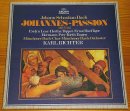
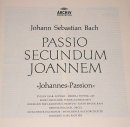

|
|
Johannes-Passion BWV 245 |
|
Karl Richter |
|
Münchener Bach-Chor
/ Münchener Bach-Orchester |
|
Tenor [Evangelist, arias, Servant]: Ernst Haefliger;
Baritone [Jesus]: Hermann Prey, Soprano
[Arias, Maid]: Evelyn Lear; Contralto
[Arias]: Hertha Töpper; Bass [Arias,
Petrus, Pilatus]: Kieth Engen
Instrumental Soloists: Walter Theurer (German Flute); Edgar Shann/Kurt Hausmann
(Oboe I/II, Oboe d'amore, & Oboe da caccia I/II); Valentin Härtel/Kurt
Christian Stier (Viola d'amore I/II); Oswald Uhl (Viol); Karl Scheit (Lute)
Continuo: Kurt Engert, Oswald Uhl (Violoncello); Karl Kolbinger, Detlev Kühl
(Bassoon); Fritz Ortner (Double-bass; Hedwig Bilgram (Organ) |
|
Archiv Produktion 2722027 (1964)
Archive Production ýARC-3228/30; APM-14828/30 (1964)
Мелодия ý33Д 033629-34 (1973)
Мелодия C10-21753-006
Archiv Produktion ý413622-2 (1984)
Deutsche Grammophon ý– 413944-1 (1989)
Archiv Produktion 435947-2 (1992)
Universal Japan POCA-9055 (2012) |
Feb 1-4, 7-15, 20-22, 1964 |
3-LP / TT: 128:22
3-LP / TT: 128:22
3-LP / TT: 128:22
3-LP / TT: 128:22
2-CD / TT: 128:57
2-CD / TT: 128:57
3-LP / TT: 128:22
2-CD / TT: 128:57 |
|
Recorded at Herkules-Saal, Munich, Bavaria, Germany.
Producer: Dr. Manfred Richter; Technical Superviser: Heinz Wildhagen.
2nd recording of Johannes-Passion BWV 245 by K. Richter.
Discussions: Johannes-Passion BWV 245 - conducted By Karl Richter
Listen on YouTube:
Johannes-Passion BWV 245 w/ music sheets [128:21]: Part 1
[63:15] + Part 2
[65:06] | Complete Work
[130:18]
Buy this album at:
Archiv 2-CD (1992): Amazon.com
| Amazon.co.uk
| Amazon.de
DGG 2-CD (1996): Amazon.com
| Amazon.co.uk
| Amazon.de
DGG 2-CD (1997): Amazon.com
| Amazon.co.uk
| Amazon.de
Universal (2012): Amazon.com
| Amazon.co.uk
| Amazon.de |
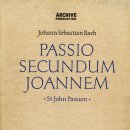
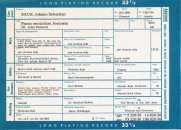

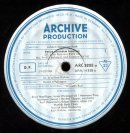
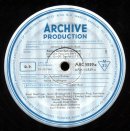
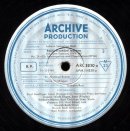
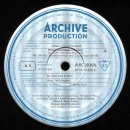
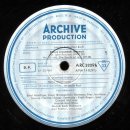

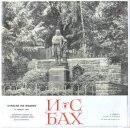
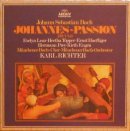
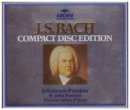

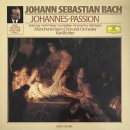

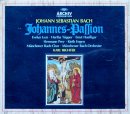
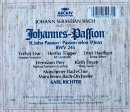
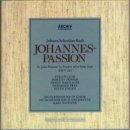 |
|
Richter’s SJP |
|
Nicholas J. Philposian wrote (February 2, 2004):
[To Rob Potharst] There are many biographies on Bach. I have a biography on Bach through letters and other documents. I also have one by Otto Bettmann which I like. Do you know of a good current biography on Bach. I am primarily interested in his years in Leipzig. I beleive his years there were very hard for him and I would like to know more. How are Albert Schweitzers and Malcolm Boyds biographies of Bach? Richter's St. John Passion is magnificant!! |
|
Neil Halliday wrote (February 2, 2004):
"Richter's St. John Passion is magnificent!!"
Absolutely agreed.
There are two blemishes, IMO.
1. The beautiful and unique "Erwaege" tenor aria is too fast.
Timing is 7.49; I would say something in the low 9's is required. (I wish we had the technology to allow the listener to select the speed, while maintaining every other parameter - not possible of course, because we would want to keep the same rate of vibrato in Haefliger's glorious voice).
"Imagine, after Christ's blood-spattered body rises to Heaven and the floods of our sins subside, a beautiful rainbow as a sign of God's grace."
This text gives every excuse to linger on the exquisite music, IMO.
2. The continuo in the "Zerfliesse, mein Herze, in Fluten der Zaehren" soprano aria - with its important repeated note figure (representing tear-drops?) - is too soft, in comparison with Lear's strong voice. Perhaps a more promiment bassoon, or a better balance between voice and orchestra, is required.
Overall, the splendour and clarity of the choruses, the quality of the soloists, and the sympathetic treatment of the recitatives, makes Richter's recording a compelling experience. |
|
Robert Sherman wrote (February 2, 2004):
IMO, Richter's SJP is more than magnificent. It is gripping, all-absorbing, draws the listener into itself in a way few performances can do.
I would, though, add one other fault to the list: Evelyn Lear's singing throughout, which strikes me as harsh and screechy. There are many soprano renditions one can splice in her place, to great improvement. |
|
Nicholas J. Philposian wrote (February 2, 2004):
[To Robert Sherman] Richter's SJP is gripping there is no doubt about it. I understand what you say about Lear's voice. However, the other soloist make up for it. I love the voice of Ernst Haefliger and Hertha Topper. They are outstanding! It is hard to imagine the genius of Bach. He wrote the SJP in only six weeks from Ash Wednesday to Good Friday 1724. I recently purchased some sacred music from Bruchner and I tell you nothing compares to the music of Bach--He is unmatched in music. Again, if anyone knows of a good biography of Bach let me know. |
|
Richard Sams wrote (February 3, 2004):
Nicholas Philiposian wrote: < Again, if anyone knows of a good biography of Bach let me know. >
I would recommend Johann Sebastian Bach: The Learned Musician by Christoph Wolff. Wolff writes very well, provides as much biographical detail as you could possibly want and, above all, puts Bach in his historical context and persuasively explains his musical development. Although Wolff clearly acknowledges Bach's genius, he is not "starry-eyed" and makes sensible judgments when evidence is lacking (as it frequently is). After reading Wolff, I have not felt the need for another Bach biography. |
| |
|
SJP - Richter's DVD - Deutche Grammophon - A warning! |
|
Ehud Shiloni wrote (April 15, 2006):
I have just finished watching this DVD, and I have a warning to those considering a purchase: On this DVD most of the arias, as well as the chorus "Rut wohll", are sung to the static background of some medieval art of gospel scenes, without giving the viewers the benefit of actually watching the performers!
I was expecting to actually see Julia Hamary singing "Es ist vohlbracht", as I suppose would anybody buying a DVD, but had to do with listening to her voice only.
So, watch out before you buy!
Other than that I liked very much what I heard and [occasionally] saw. Peter Schreier is an overwhelming evangelist, and Sigmund Nimsgern is a terrific as Petrus and Pilatus. Seeing Richter was satisfying too, a feeling of looking back into history. I believe it would have made a stronger recommendation if the "video" aspect had been treated more fairly. |
|
Robert Sherman wrote (April 15, 2006):
[To Ehud Shiloni] Would you believe a Mozart Requiem video that shows the trombone bell but never the trombonist? A Haydn's creation in which the camera is somewhere else for Emma Kirkby's first entrance? A Verdi Requiem in which the camera is somewhere else when Renee Fleming soars to her high C?
I find Ehud's issue to be a universal problem in classical music videos.
The video direction is done by drooling idiots who don't understand that music is made by musicians. They feel more comfortable with visual art, so they wander vaguely around paintings, cathedral windows, or disembodied
musical instruments.
They should all be shot -- but not in the head, because they have no vital organ there. |
|
Yoël L. Arbeitman wrote (April 15, 2006):
Robert Sherman wrote:
< Would you believe a Mozart Requiem video that shows the trombone bell but never the trombonist? A Haydn's creation in which the camera is somewhere else for Emma Kirkby's first entrance? A Verdi Requiem in which the camera isomewhere else when Renee Fleming soars to her high C?
I find Ehud's issue to be a universal problem in classical music videos. >
I assume by classical music videos you are excluding opera and ballet (I have no knowledge of the last named).
I just watched a few nights ago the Kirov-ROH production of Prokofiev's The Fiery Angel and was delighted that I both have a DVD player and a multi-region one as this is PAL region 2&5 only.
The production was a major component of the enjoyment of this odd opera and this was my first exposure to it.
Often with operas which I know I do not enjoy the DVDs but it's a case by case matter.
Most of the Bernstein Mahler DVDs are excellent except the 2nd symphony where the sound is so poor that there is no reason to bother esp. since there are endless official and private Bernstein M2s. |
|
Douglas Cowling wrote (April 15, 2006):
Video Passions
Robert Sherman wrote:
< The video direction is done by drooling idiots who don't understand that music is made by musicians. They feel more comfortable with visual art, so they wander vaguely around paintings, cathedral windows, or disembodied musical instruments.
They should all be shot -- but not in the head, because they have no vital organ there. >
As an example of superb video direction, see Jonathan Miller's production of the SJP (or was it the SMP (BWV 244)?) which begins as a film of a rehearsal but gradually becomes a dramatic piece of cinema.
My first encounter with the SMP (BWV 244) was through a dramatized version produced by NBC in 1960 (?) -- those days are long gone.! The evangelist part was sung by the tenor dressed as a modern cleric reading from the bible in a
contemporary church with the congregation in contemporary dress singing the chorales in the pews. The recitatives were sung as voice-overs to mimed action in biblical dress, so one had the interesting experience of seeing the chorus as the angry crowd followed by a chorale with the same people as contempoarary church-goers. The arias were sung by singers in biblical dress standing as if looking on to the action. It was an extremely effective concept. |
|
Yoël L. Arbeitman wrote (April 15, 2006):
Douglas Cowling wrote:
< The recitatives were sung as voice-overs to mimed action in biblical dress, so one had the interesting experience of seeing the chorus as the angry crowd followed by a chorale with the same people as contempoarary church-goers. The arias were sung by singers in biblical dress standing as if looking on to the action. It was an extremely effective concept. >
Biblical dress? Perhaps in quotes? |
|
Robert Sherman wrote (April 15, 2006):
[To Yoël L. Arbeitman] Correct, I wasn't counting opera or ballet. |
|
Thomas Shepherd wrote (April 15, 2006):
[To Robert Sherman] The argument that we are a visual rather than an auditory society was very well discussed by Daniel Barenboin in his second Reith lecture yesterday. He fulminated against the banalities of muzak.
http://www.bbc.co.uk/radio4/reith2006/
Lecture audio, MP3 downloads and transcripts available. |
|
Robert Sherman wrote (April 15, 2006):
Yoël L. Arbeitman wrote:
< Biblical dress? Perhaps in quotes? >
Biblical-appearing, I guess. But Doug, how do you know they were miming? I thought they were really singing. Maybe I was young and gullible. |
|
Douglas Cowling wrote (April 15, 2006):
Oberammergau Passion Music
Yoël L. Arbeitman wrote:
< Biblical dress? Perhaps in quotes? >
LOL ... Hollywood biblical dress is probably more accurate.
Has anyone been to Oberammergau? I'm curious about the music used. I read somewhere that it's a Wagnerian pastiche from the Bach Passions. Anyone know when Bach entered the performance history and who did the arrangements? Was it early enough to have influenced Wagner's theatrical concept for the Bayreuth Festspielhaus.
Certainly the stage designer and director, Adolph Appia, who pioneered the modern Bayreuth minimalist style had an unfulfilled project to stage the SMP (BWV 244) using all the lighting and stage design of modern theatre.
Interesting stage designs for Edward Craig's production of the SMP (BWV 244) and Appia's Die Walküre at: http://www.kent.ac.uk/sdfva/kidds/historical.html |
|
Julian Mincham wrote (April 15, 2006):
Douglas Cowling wrote:
< As an example of superb video direction, see Jonathan Miller's production of the SJP (or was it the SMP (BWV 244)?) which begins as a film of a rehearsal but gradually becomes a dramatic piece of cinema. >
This was, indeed an extraordinary production which deserves much greater acclaim. The musical director was Paul Goodwin and the singers (amongst others) were Richard jackson, Nancy Argenta, Jamie McDonald and Stephen Barcoe. (It was, by the way the SMP (BWV 244))
The singers used no music copies and were dressed in contemporary casual clothing. They moved in and around the orchestra (small groups, 3 first 2 second violins and one viola and cello) and inter related with each other. The effect was entirely tele-visual and greatly moving--a text book example of how to successfully translate a work of this kind into the TV medium.
It was broadcast by the BBC, at a guess around 1990 but it may have been earlier. I don't know if it has been released on DVD and would be interested if anyone knows. It was quite ground breaking at the time.
By the way a second request as I had no responses to the first-----possibly because noone knows. But is anyone aware of , or has some or all of the 1950s recording of the SMP (BWV 244) conducted by Vaughn Williams? |
| |
|
SJP - Richter's DVD - Deutche Grammophon |
|
Pal Domokos wrote (September 1, 2006):
Ehud Shiloni wrote:
< I have just finished watching this DVD, and I have a warning to those considering a purchase: On this DVD most of the arias, as well as the chorus "Rut wohll", are sung to the static background of some medieval art of gospel scenes, without giving the viewers the benefit of actually watching the performers!
I was expecting to actually see Julia Hamary singing "Es ist vohlbracht", as I suppose would anybody buying a DVD, but had to do with listening to her voice only.
So, watch out before you buy!
Other than that I liked very much what I heard and [occasionally] saw. Peter Schreier is an overwhelming evangelist, and Sigmund Nimsgern is a terrific as Petrus and Pilatus. Seeing Richter was satisfying too, a feeling of looking back into history. I believe it would have made a stronger recommendation if the "video" aspect had been treated more fairly. >
I wish I had read this post before I bought Richter's SJP on DVD today. I simply can't think of a reason why, instead of seeing the performers, somebody would want to watch murals while listening to the music.
The performance itself is great, it sounds just as good to me as that on Richter's CD (with a definite advantage of having Helen Donath as soprano rather than Evelyn Lear).
Deutsche Grammophon also released the SMP (BWV 244) and the Mass in B minor (BWV 232) with Richter on DVD. Does anybody know if these are also visually challenged?
Ehud: thanks for the warning, anyway. Next time I'll search the archive first.
the listener is I still can't really beleive that any visual director |
|
Uri Golomb wrote (September 2, 2006):
Paul Domkos wrote:
< Deutsche Grammophon also released the SMP (BWV 244) and the Mass in B minor (BWV 232) with Richter on DVD. Does anybody know if these are also visually challenged? >
Neither the SMP (BWV 244) nor the MBM (BWV 232) were filmed during live concerts; however, in both cases, the musicians are more consistently visible than in the SJP.
The M(BWV 232) was directed by Arne Arnbom, who also directed the SJP, and it was filmed at the same church. There are many moments when the camera strays from the performers and shows some of the profuse paintings that decorate this (very obviously catholic) church; but still, we do get to see the musicians most of the time. In the SJP, there are whole arias where the singers are entirely invisible; in the MBM (BWV 232) this doesn't happen.
the SMP (BWV 244) was directed by Hugo Kaech, and filmed at a studio. A special set was erected for that purpose, which can be glimpsed on http://www.unitel.de/ucatalog/concert/61_2.htm; the set was very clearly inspired by Salvador Dali's controversial painting "Christ of St. John of the Cross", which can be seen on http://tinyurl.com/5xgoe. Kaech made it very clear that the film was pasted together from several sessions, rather than representing a continuous performance. For example, the two choruses are very clealry separated in the film -- but in the chorales, they unite and stand closely together, as a single group. It seems highly likely that all the chorales were filmed in one session, or one series of sessions, separate from the session devoted to the choral numbers. Also, during many of the arias, you can see very clearly that the huge steps, on wh! ich the choir normally stood, are empty: the choir was not present during the taping of these arias. Of course, tehre is nothing unusual about this: that's how such recordings are often done; but it is interesting that Kaech has chosen to highlight this in his film, and made no attempt whatsoever to disguise these discontinuities.
Kaech's conception is very dramatic: there are striking camer movements and tricks of lightning and staging in several key moments. He has clearly thought deeply about how to convey the drama of the Passion, and his discontinuous approach might be related to this: it clearly separates the reflective portions of the work (chorales, arias) from the narrative portions. I don't always find his approach convincing; but it's definitely worth viewing.
I've doen a lecture on these films a while ago (before they even came out on DVD -- I had access to videotapes, filmed from televised broadcasts) -- the abstract can be seen on http://www.charm.rhul.ac.uk/content/events/sma_abstracts.html . I hope to prepare an article version of this lecture, perhaps with a view of posting it on Aryeh's website. |
|
Robert Sherman wrote (September 2, 2006):
[To Uri Golomb] Thanks for the great review, Uri. Sounds as if the SMP (BWV 244) is my kind of video. I couldn't care less if the stage settings change, although I like the integrity of having all the chorales done one way, the double choruses another, etc. And out of ten top priorities, numbers one through ten should be getting the cameras on the performers. Certainly, they should never emulate ADD by wandering around the church scenery. |
|
Pal Domokos wrote (September 3, 2006):
[To Uri Golomb] Thanks for all the info, Uri! I would certainly read your article on the films.
I feel much better about the SJP DVD, by the way. I watch it with my eyes closed - the sound is absolutely great. Perhaps it could have been performed with a hundred people less but who heard about OVPP in 1971?
Tomorrow I'll buy the SMP (BWV 244). I think I'll pass the Mass in B minor (BWV 232) for now.
Do you know that somebody made a fairly strange film out of Richter's SJP? The 1964 recording of the SJP can be heard all along (with Haefliger, Hamari, etc.) but what we see is the story of the passion actually played by other people, actors probably. Somebody appears to sing the aria "Von den Strichen" but it's Hamari's voice we can hear. Someone else pretends to sing the "Ich folge dich gleichweis" aria, and yes, it's Evelyn Lear's voice. But Haefliger plays himself!
I like some parts of the film, where the visual settings add something to the music or enhance it some way. I even remember to be moved to tears (a bit!) a couple of times while watching it. Which was long ago: I recorded it onto VHS from TV in the early nineties, I guess. I still probably have the tape somewhere; I'll find it if you're interested. |
|
Yoël L. Arbeitman wrote (September 3, 2006):
Pal Domokos wrote:
< Do you know that somebody made a fairly strange film out of Richter's SJP? The 1964 recording of the SJP can be heard all along (with Haefliger, Hamari, etc.) but what we see is the story of the passion actually played by other people, actors probably. Somebody appears to sing the aria "Von den Strichen" but it's Hamari's voice we can hear. Someone else pretends to sing the "Ich folge dich gleichweis" aria, and yes, it's Evelyn Lear's voice. But Haefliger plays himself! >
I have watched a few opera films like this recently where actors play the roles and famed singers sing. Often the lip-synching is inadequate but one can get used to it. Also sometimes one singer will both act and sing whilst all the others are substituted for my actors. |
| |
Johannes-Passion BWV 245 :
Details
Complete Recordings:
1900-1949
| 1950-1959
| 1960-1969
| 1970-1979
| 1980-1989
| 1990-1999
| 2000-2009
| 2010-2019
| 2020-2029
| Complete Recordings sung in English
| Recordings of Individual Movements
General Discussions:
Part 1
| Part 2
| Part 3
| Part 4
| Part 5
| Part 6
| Part 7
| Part 8
Systematic Discussions:
Part 1: Mvts. 1-7
| Part 2: Mvts. 6-14
| Part 3: Mvts. 15-20
| Part 4: Mvts. 21-26
| Part 5: Mvts. 27-32
| Part 6: Mvts. 36-40
| Part 7: Summary
Individual Recordings:
BWV 245 - F. Brüggen
| BWV 245 - S. Cleobury
| BWV 245 - P. Dombrecht
| BWV 245 - D, Fasolis
| BWV 245 - J.E. Gardiner
| BWV 245 - E.z. Guttenberg
| BWV 245 - N. Harnoncourt-H. Gillesberger
| BWV 245 - P. Herreweghe
| BWV 245 - E. Higginbottom
| BWV 245 - E. Jochum
| BWV 245 - E. Kleiber
| BWV 245 - P.J. Leusink
| BWV 245 - H. Max
| BWV 245 - P. McCreesh
| BWV 245 - H. Münch
| BWV 245 - P. Neumann
| BWV 245 - A. Parrott
| BWV 245 - P. Pickett
| BWV 245 - K. Richter
| BWV 245 - H. Rilling
| BWV 245 - P. Schreier
| BWV 245 - R. Shaw
| BWV 245 - K. Slowik
| BWV 245 - M. Suzuki
| BWV 245 - J.v. Veldhoven
Articles:
Saint John Passion, BWV 245 [T.N. Towe]
| The Passion of Saint John, BWV 245 [M. Steinberg]
| St. John Passion [A. Wong & N. Proctor]
| The St. John Passion on stage [U. Golomb]
| Literary Origins of Bach’s St. John Passion: 1704-1717 [W. Hoffman]
| Bach’s Passion Pursuit [W. Hoffman]
| Bach's St. John Passion and its Dramatic History of Origin [M. Maul]
Karl Richter :
Short Biography
Ensembles: Münchener Bach-Chor
| Münchener Bach-Orchester
Bach Discography:
Recordings of Vocal Works:
Part 1
| Part 2
| Recordings of Instrumental Works
Discussions:
General Discussions
| Richter's Video
Vocal Works:
BWV 232 - K. Richter
| BWV 244 - K. Richter
| BWV 245 - K. Richter
| BWV 248 - K. Richter
Reviews of Instrumental Recordings:
Famous Bach Organ Works from K. Richter
| K. Richter Performs Bach’s Partitas & Goldbergs
| Review: Brandenburg Concertos Nos. 1, 2 & 5 - conducted by K. Richter
Table of recordings by BWV Number
|